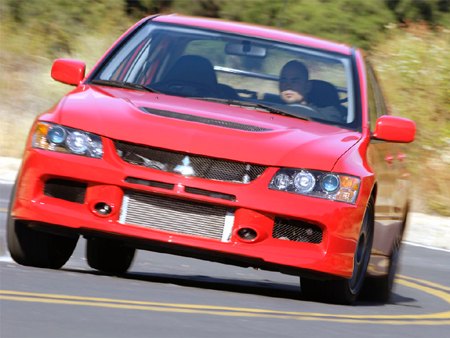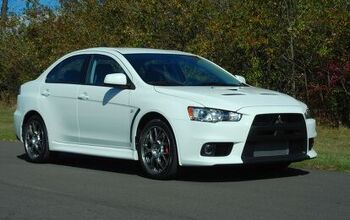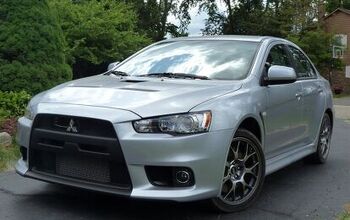Mitsubishi Evo IX MR Review
There’s an industrial road outside Chicago that has more Mitsubishi Lancer Evolutions per square mile than anywhere but the factory in Mizushima, Japan. There’s the drag race shop with several 600+hp, carbon- paneled versions vying for space. There’s the tuner shop where literally dozens of Evos flock to dyno. And there’s the rally shop that is widely considered the finest American skunkworks for this type of car. And as I stand in that shop, my own flame-spitting Evo IV rally car sitting on the hoist behind me, I stare at a brand-new charcoal Evo IX MR – the even-higher-performance-spec version – that has only 70 miles on it. And the perfect impression of a tree trunk, molded into the passenger’s side.
The sight is sobering. I mean, I’ve been driving my own Evo on dirt and snow rally roads for years, at speeds regularly over 120mph, and I’ve never hit a tree like this poor schmuck did. But then I’ve been rallying for a long time and have enough stupid crashes on my permanent record to know better than continue down that path (and over the forest and into the tree). Fortunately, there’s another near-new Evo IX MR sitting outside, and the owner foolishly throws me the keys.
I’m not a boy racer. I’m not even a boy. But boy, the IX MR is quite a car. It’s not particularly elegant; the best you could say is that the fender flares, sharp nose, deep chin, and hard-edged wing make it handsome and sinewy. The interior is downright plain for a $35k sports sedan (OK – the Recaro seats are awesome). Unmodified, it actually sits a little too high on its wheels. Unless you know what it is, you’d probably think this bewinged extrovert is like your little brother: high on bluster but slow on the delivery.
But this is your little brother who becomes the school track star and steals your girlfriend. Specs never tell the whole story, but 286hp, AWD with an active center differential, huge Brembo brakes, and all-aluminum suspension arms make for a good opening paragraph. The story continues when you fire up the 2.0L intercooled turbo engine – in the IX for the first time with variable valve timing – and it settles into a contented purr. It’s not until you really get into the throttle that the thing takes off like a scalded cat, albeit a scalded cat with its claws dug about two feet into the pavement.
I can tell you with some authority that this is one of the five best handling cars available in North America. Certainly it is one of two for less than $35k, and it has four doors and a trunk to boot. It’s better than the Subaru WRX STi – tighter, better balanced, transitions faster, feels lighter. The Subaru actually has a better drive layout, with the engine mass lower and the transmission further back, but by sheer bloody-minded suspension engineering the Evo wins hands down.
Yes, the ride is harsh and the appointments spare. But the turn-in is astonishing – sneeze and you’ll change three lanes – and once you’re sliding, you can drift the car in fourth gear, tires smoking, the world coming at you through the side window, correcting with your fingertips. Wanna feel like a superhero? This is your fastest ticket.
Except physics is a hard mistress, and trees are hard objects. Even the Evo can’t give you more run-out room when you simply went in too fast. In fact, it sort of cheats you: it allows you to go so close to the edge – even over the edge – then gather it all up again, time after time. Except that last time when nothing – not your skill, not your pleas to the heavens, and not even the Evo – can save you from being an idiot.
Anyway, the IX MR is that kind of car: a machine that goes so bloody quick so bloody easily that thoughts of death are necessary to prevent its occurrence. And no wonder: the IX MR is an evolution of an earlier Lancer and, before that, the Galant VR4 of the early 1990s. The Evo is, essentially, a Japanese Porsche 911, constantly honed with one thing in mind: dominant performance for a given drive layout. It’s amazing that a company still struggling to find its place in the North American market can produce a single model that is so focused, desirable and damn near perfect that they hardly need to market it.
And so, after having driven perhaps a dozen Evos in anger over the last few years, there’s a new Evo IX RS – the even-lighter-weight version – sitting in my shop, taunting me, about to be built into my next rally car. So much for trying not to be an idiot.
More by Andrew Comrie-Picard
Latest Car Reviews
Read moreLatest Product Reviews
Read moreRecent Comments
- Bkojote Allright, actual person who knows trucks here, the article gets it a bit wrong.First off, the Maverick is not at all comparable to a Tacoma just because they're both Hybrids. Or lemme be blunt, the butch-est non-hybrid Maverick Tremor is suitable for 2/10 difficulty trails, a Trailhunter is for about 5/10 or maybe 6/10, just about the upper end of any stock vehicle you're buying from the factory. Aside from a Sasquatch Bronco or Rubicon Jeep Wrangler you're looking at something you're towing back if you want more capability (or perhaps something you /wish/ you were towing back.)Now, where the real world difference should play out is on the trail, where a lot of low speed crawling usually saps efficiency, especially when loaded to the gills. Real world MPG from a 4Runner is about 12-13mpg, So if this loaded-with-overlander-catalog Trailhunter is still pulling in the 20's - or even 18-19, that's a massive improvement.
- Lou_BC "That’s expensive for a midsize pickup" All of the "offroad" midsize trucks fall in that 65k USD range. The ZR2 is probably the cheapest ( without Bison option).
- Lou_BC There are a few in my town. They come out on sunny days. I'd rather spend $29k on a square body Chevy
- Lou_BC I had a 2010 Ford F150 and 2010 Toyota Sienna. The F150 went through 3 sets of brakes and Sienna 2 sets. Similar mileage and 10 year span.4 sets tires on F150. Truck needed a set of rear shocks and front axle seals. The solenoid in the T-case was replaced under warranty. I replaced a "blend door motor" on heater. Sienna needed a water pump and heater blower both on warranty. One TSB then recall on spare tire cable. Has a limp mode due to an engine sensor failure. At 11 years old I had to replace clutch pack in rear diff F150. My ZR2 diesel at 55,000 km. Needs new tires. Duratrac's worn and chewed up. Needed front end alignment (1st time ever on any truck I've owned).Rear brakes worn out. Left pads were to metal. Chevy rear brakes don't like offroad. Weird "inside out" dents in a few spots rear fenders. Typically GM can't really build an offroad truck issue. They won't warranty. Has fender-well liners. Tore off one rear shock protector. Was cheaper to order from GM warehouse through parts supplier than through Chevy dealer. Lots of squeaks and rattles. Infotainment has crashed a few times. Seat heater modual was on recall. One of those post sale retrofit.Local dealer is horrific. If my son can't service or repair it, I'll drive 120 km to the next town. 1st and last Chevy. Love the drivetrain and suspension. Fit and finish mediocre. Dealer sucks.
- MaintenanceCosts You expect everything on Amazon and eBay to be fake, but it's a shame to see fake stuff on Summit Racing. Glad they pulled it.





































Comments
Join the conversation
I have a EVO 8 RS. I have owned all kinds of cars before this car (Porsche, VW, Audi, Mercedes, GM/Ponitac, Isuzu, an other Mitsubishi, and a Chrysler), and all I can say is ... I LOVE MY EVO. I love this car so much, I can't wait to up every morning and drive it to work. I wish there was a mountain between my home and office. I must admit, I am a automotive enthusiast and enjoy sport over comfort. But even if you only compare the EVO to other pure sports cars, there is no comparison. The only time I will get another car is replace this one with a new EVO. I think my wife will burry me in my EVO, which is fine by me.
[...] http://www.thetruthaboutcars.com/mitsubishi-evo-ix-mr/ [...]